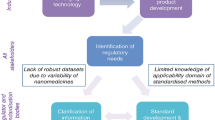Abstract
Purpose
Nanosuspensions, as a promising strategy to improve the solubility and bioavailability of poorly water soluble drugs, have been widely investigated in recent years. However, no comprehensive work so far has detailed the effect of independent processing/formulation parameters on the quality of the prepared nanosuspension.
Methods
In the present study, the relations between solvent flow rate, stirring rate of antisolvent and surfactant concentration (i.e., inputs) on size, and polydispersity index (PDI) (i.e., outputs) of an N-acetylcysteine nanosuspension were investigated using artificial neural networks (ANNs).
Results and conclusion
The response surfaces, generated as 3D graphs after ANNs modeling, demonstrated that all the three factors have a reverse effect on size and PDI. The dominant factor appeared to be the concentration of surfactant. Overall, it was found that the optimum formulation (i.e., minimum size and PDI value) is obtained at high values of surfactant concentration, solvent flow rate, and stirring rate (i.e., >0.9 mg/ml and 120 ml/h and 500 rpm, respectively).






Similar content being viewed by others
References
Aghajani, M., A. R. Shahverdi, S. M. Rezayat, M. A. Amini and A. Amani. Preparation and optimization of acetaminophen nanosuspension through nanoprecipitation using microfluidic devices- an artificial neural networks study. Pharm Dev Technol: 2012. In press.
Amani, A. and D. Mohammadyani. Artificial Neural Networks: Applications in Nanotechnology. Artificial Neural Networks- Application. C.-L. Hui. Rijeka, INTECH. 2011.
Amani A, York P, Chrystyn H, Clark BJ. Factors affecting the stability of nanoemulsions—Use of artificial neural networks. Pharm Res. 2010;27(1):37–45.
Amani A, York P, Chrystyn H, Clark BJ, Do DQ. Determination of factors controlling the particle size in nanoemulsions using artificial neural networks. Eur J Pharm Sci. 2008;35(1–2):42–51.
Amidon GL, Lennernas H, Shah VP, Crison JR. A theoretical basis for a biopharmaceutic drug classification: the correlation of in vitro drug product dissolution and in vivo bioavailability. Pharm Res. 1995;12(3):413–20.
Bas D, Boyacı İH. Modeling and optimization II: Comparison of estimation capabilities of response surface methodology with artificial neural networks in a biochemical reaction. J Food Eng. 2007;78(3):846–54.
Belbella A, Vauthier C, Fessi H, Devissaguet J-P, Puisieux F. In vitro degradation of nanospheres from poly (D, L-lactides) of different molecular weights and polydispersities. Int J Pharm (Amsterdam, Neth). 1996;129(1):95–102.
Bodmeier R, McGinity JW. Solvent selection in the preparation of poly (DL-lactide) microspheres prepared by the solvent evaporation method. Int J Pharm (Amsterdam, Neth). 1988;43(1):179–86.
Chen X, Young TJ, Sarkari M, Williams RO, Johnston KP. Preparation of cyclosporine a nanoparticles by evaporative precipitation into aqueous solution. Int J Pharm (Amsterdam, Neth). 2002;242(1):3–14.
Chingunpituk J. Nanosuspension technology for drug delivery. Walailak J Sci & Tech. 2007;4(2):139–53.
Dekhuijzen PNR. Antioxidant properties of N-acetylcysteine: their relevance in relation to chronic obstructive pulmonary disease. Eur Respir J. 2004;23(4):629–36.
Esmaeilzadeh-Gharedaghi, E., M. A. Faramarzi, M. A. Amini, A. Rouholamini Najafabadi, S. M. Rezayat and A. Amani. Effects of processing parameters on particle size of chitosan nanoparticles prepared using sonication methodology: an artificial neural networks study. Pharm Dev Technol. 2013. In press.
Gradl J, Peukert W. Characterization of micro mixing for precipitation of nanoparticles in a T-mixer. Micro Macro Mixing. 2010;49:105–24.
Gregg, K. A. Synthesis, characterization and morphological control of transition metal pnictide nanoparticles: Influence of size and shape on magnetic properties. PhD, Wayne State University; 2007.
IntelligensysLtd. INForm Manual; 2009.
Kakran M, Sahoo NG, Tan IL, Li L. Preparation of nanoparticles of poorly water-soluble antioxidant curcumin by antisolvent precipitation methods. J Nanopart Res. 2012;14:751.
Kesisoglou F, Panmai S, Wu Y. Nanosizing–oral formulation development and biopharmaceutical evaluation. Adv Drug Deliv Rev. 2007;59(7):631–44.
Lieberman, H. A. Pharmaceutical dosage forms: Disperse systems, Informa HealthCare; 1998.
Lipinski CA. Poor aqueous solubility-an industry wide problem in ADME screening. Am Pharm Rev. 2002;5:82–5.
List, M. and H. Sucker. Hydrosols of pharmacologically active agents and their pharmaceutical compositions comprising them, US Patent 5,389,382. 1995.
Liu D, Xu H, Tian B, Yuan K, Pan H, Ma S, et al. Fabrication of carvedilol nanosuspensions through the anti-solvent precipitation-ultrasonication method for the improvement of dissolution rate and oral bioavailability. AAPS PharmSciTech. 2012;13(1):295–304.
Liversidge GG, Cundy KC. Particle size reduction for improvement of oral bioavailability of hydrophobic drugs: I. Absolute oral bioavailability of nanocrystalline danazol in beagle dogs. Int J Pharm (Amsterdam, Neth). 1995;125(1):91–7.
Patravale VB, Date AA, Kulkarni RM. Nanosuspensions: a promising drug delivery strategy. J Pharm Pharmacol. 2004;56(7):827–40.
Rowe RC, Roberts RJ. Intelligent software for product formulation. London: Taylor & Francis, Inc; 1998.
Sattler KD. Nanoparticles and quantum dots. Boca Raton: CRC Press; 2010.
Shao Q, Rowe RC, York P. Comparison of neurofuzzy logic and neural networks in modelling experimental data of an immediate release tablet formulation. Eur J Pharm Sci. 2006;28(5):394–404.
Sinko P. Martin’s physical pharmacy and pharmaceutical sciences. Philadelphia: Lippincott Williams & Wilkins; 2006.
Zhang X, Xia Q, Gu N. Preparation of all-trans retinoic acid nanosuspensions using a modified precipitation method. Drug Dev Ind Pharm. 2006;32(7):857–63.
Acknowledgment
This research was supported by Iran National Science Foundation, grant No. 91003529.
Author information
Authors and Affiliations
Corresponding author
Rights and permissions
About this article
Cite this article
Abbasi, S., Afrasiabi, A., Karimi Zarchi, A.A. et al. Preparation and Optimization of N-Acetylcysteine Nanosuspension through Nanoprecipitation: An Artificial Neural Networks Study. J Pharm Innov 9, 115–120 (2014). https://doi.org/10.1007/s12247-014-9178-1
Published:
Issue Date:
DOI: https://doi.org/10.1007/s12247-014-9178-1




